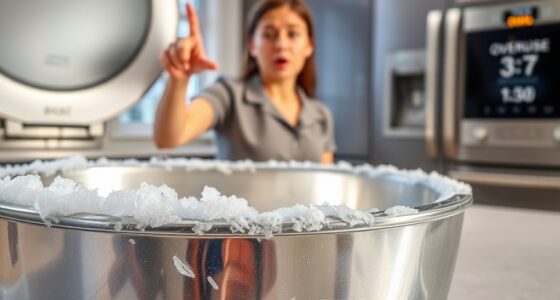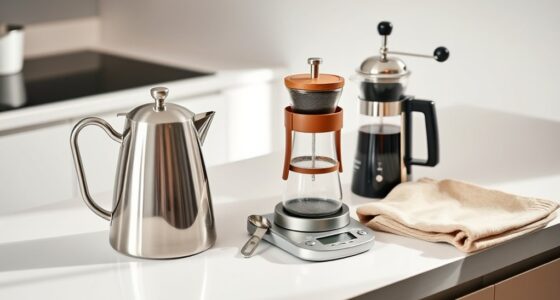Double-walled glasses keep your coffee hotter longer by using vacuum insulation and air gaps that slow heat transfer. The vacuum between the walls acts as a barrier against conduction and convection, while tiny air pockets further insulate by reducing heat flow. The design minimizes moisture on the outside and maintains temperature. Understanding how these features work together can help you appreciate why your drink stays warm so well—if you keep exploring, you’ll learn even more.
Key Takeaways
- The vacuum gap between glass layers minimizes heat transfer by eliminating air molecules, reducing conduction and convection.
- Air pockets or tiny bubbles act as insulators, further slowing heat loss through conduction and convection.
- Double-walled construction creates a thermal barrier that helps maintain beverage temperature longer.
- The material choice (glass or ceramic) influences heat retention, durability, and insulation efficiency.
- The design’s air gaps and vacuum work together to prevent condensation and keep hot beverages warmer for extended periods.
What Are Double-Walled Glasses?
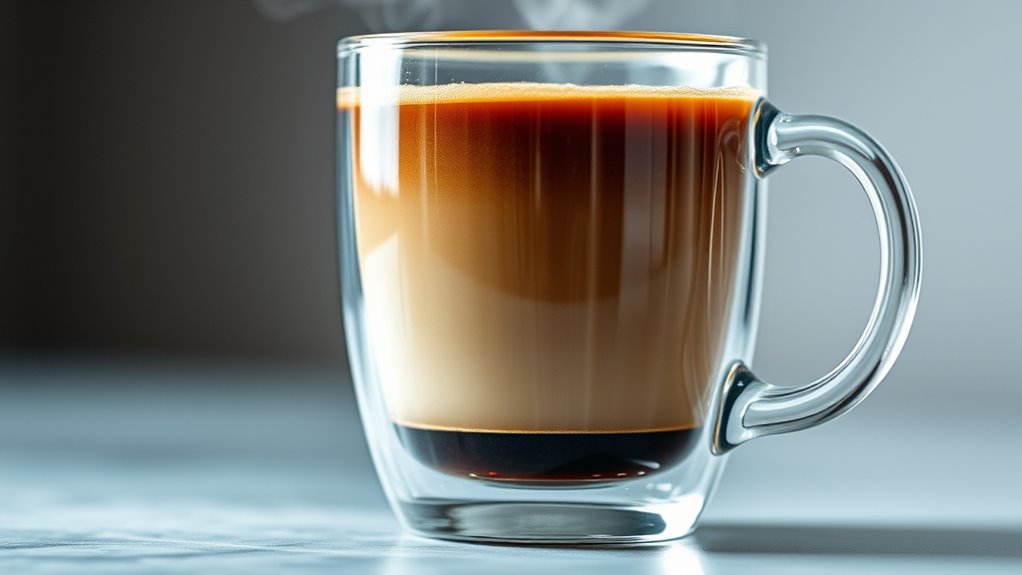
Double-walled glasses are specially designed glassware featuring two layers of glass with a space in between. This design has a rich historical evolution, dating back to traditional glass-blowing techniques in the Middle East and Asia. Over centuries, these glasses gained cultural significance as symbols of craftsmanship and innovation. Today, they’re popular for their ability to insulate beverages, keeping drinks hot or cold longer while preventing condensation. The double-wall construction creates a visual floating effect, making drinks appear to hover. This aesthetic appeal has contributed to their popularity worldwide. Additionally, the insulating properties of double-walled glasses enhance the drinking experience by maintaining beverage temperature and reducing heat transfer. Understanding their historical roots and cultural importance helps you appreciate not just their functionality but also their place in the evolution of glassware design, blending tradition with modern science.
The Role of Vacuum Insulation
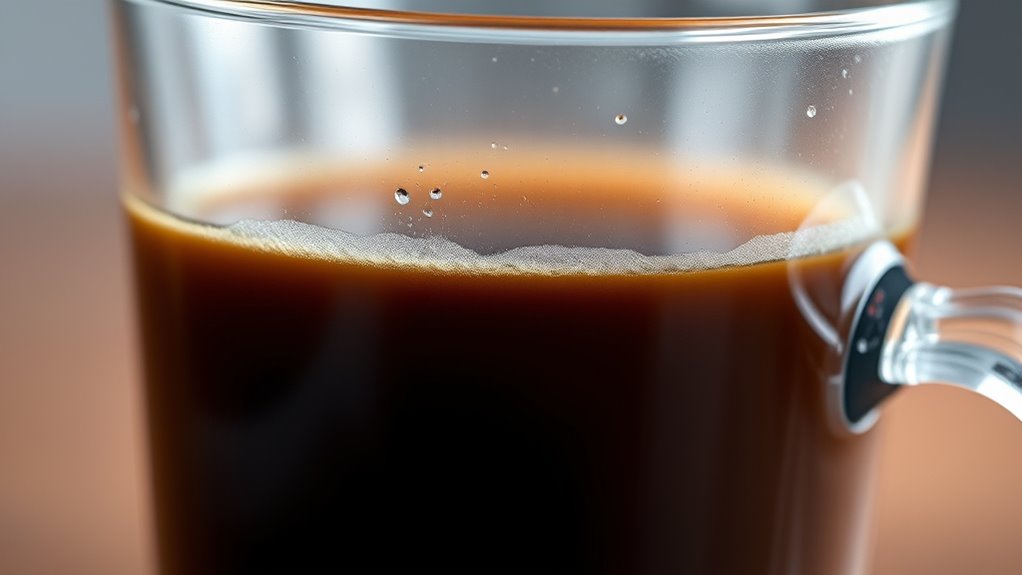
The vacuum between the glass walls acts as an effective insulation barrier, stopping heat from passing through. Because there’s no air to conduct or convect heat, your beverage stays hot or cold longer. This is the key reason vacuum insulation keeps your drinks at the perfect temperature. Additionally, the insulation technology used in double-walled glasses prevents heat transfer more efficiently than traditional single-walled designs.
Vacuum Creates Insulation Barrier
Ever wonder how double-walled glasses keep your drinks hot or cold for so long? It’s because the vacuum between the walls acts as an insulator, blocking heat transfer. This vacuum creates an effective insulation barrier, preventing both heat loss and gain. Since there’s no air or moisture to conduct or convect heat, your beverage stays at the desired temperature longer. Additionally, the vacuum’s strength not only enhances insulation but also contributes to the material durability, making these glasses resistant to cracks and damage over time. The sleek, transparent design enhances the aesthetic appeal, giving your drinkware a modern, elegant look. The vacuum’s role is essential in maintaining thermal stability without sacrificing style, allowing you to enjoy your hot coffee or cold drink for extended periods without compromise.
Prevents Heat Transfer Effectively
The vacuum between the glass walls works like a barrier that sharply reduces heat transfer through conduction and convection. This minimizes the transfer of thermal energy, keeping your coffee hot longer. The vacuum’s effectiveness hinges on low thermal conductivity and material durability, preventing heat flow while resisting damage. Additionally, the contrast ratio plays a role in how well the insulation performs visually by affecting the perception of warmth and clarity. To understand how it works: 1. The vacuum eliminates air molecules, reducing conduction and convection. 2. The glass walls are made from durable, heat-resistant materials to withstand temperature changes. 3. The design ensures minimal thermal transfer, maintaining temperature without compromising the glass’s strength.
This combination of vacuum insulation and strong materials ensures your beverage stays hot longer without the risk of heat loss or damage to the glass.
Maintains Beverage Temperature
Vacuum insulation plays an essential role in maintaining your beverage’s temperature by markedly reducing heat loss. Since vacuum acts as an excellent insulator, it considerably lowers the thermal conductivity between the inner and outer walls, preventing heat from escaping or entering. This means your hot coffee stays warm longer, and your cold drink remains cool. The material durability of the glass also contributes to this effectiveness, as high-quality materials resist damage and maintain their insulating properties over time. Without a vacuum, heat would transfer more readily through conduction, undermining the insulation. By minimizing thermal conductivity and ensuring robust construction, vacuum insulation ensures your beverage stays at the perfect temperature for extended periods, making your coffee experience more enjoyable and efficient. Additionally, incorporating mindfulness techniques can help you appreciate the sensory experience of enjoying your beverage at the ideal temperature.
How Air Gaps Reduce Heat Transfer
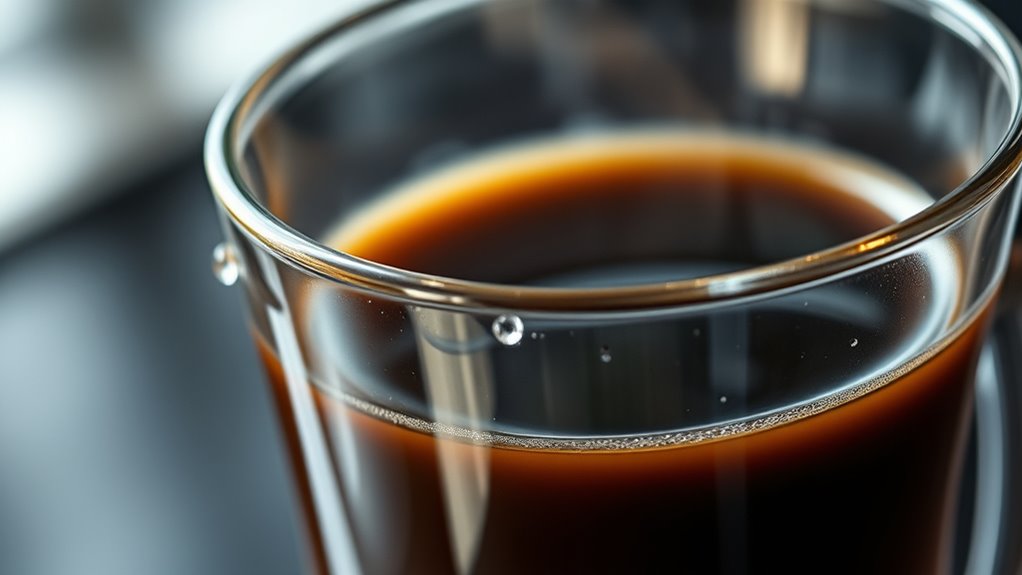
When you look at double-walled glasses, notice the air pockets trapped between the walls. These insulating pockets slow down heat transfer by reducing conduction and convection. As a result, your beverage stays hot or cold longer, thanks to this effective thermal barrier. Additionally, the air gap prevents direct contact between the hot liquid and the outer surface, reducing the risk of burns.
Insulating Air Pockets Formation
Because air is a poor conductor of heat, the formation of insulating air pockets between the glass walls considerably slows heat transfer. These air gaps act as barriers, reducing thermal conductivity and creating effective air cushioning. To visualize this, imagine:
- Tiny bubbles of still air trapped between the glass layers, acting as insulation.
- A barrier that prevents direct contact, limiting heat flow via conduction.
- Layers of still air that slow the transfer of heat through convection and radiation.
This air cushioning minimizes heat loss, helping your coffee stay hotter longer. The trapped air’s low thermal conductivity makes it an excellent insulator, markedly enhancing the double-walled design’s ability to retain warmth. Effective insulation from these air pockets is crucial for maintaining temperature. These insulating air pockets are key to the effectiveness of double-walled glasses.
Slowing Conduction and Convection
Air gaps in double-walled glasses play an essential role in slowing heat transfer by disrupting the usual paths heat takes. They reduce thermal conductivity, meaning heat struggles to pass through the air barrier, which is much less conductive than glass or metal. This interruption slows conduction, preventing heat from quickly moving from the hot liquid to your hands. Additionally, these air pockets hinder convection currents within the gap, limiting the movement of warm air that would otherwise transfer heat. The design also enhances material durability by preventing direct contact between the inner and outer walls, reducing stress from temperature changes. As a result, your beverage stays hotter longer, and the glass remains comfortable to hold, thanks to these carefully engineered air gaps that act as natural insulators. Moreover, understanding AI security vulnerabilities can inform the development of more resilient insulating materials that adapt to temperature fluctuations.
Enhanced Thermal Barrier
The air gaps in double-walled glasses act as effective thermal barriers by considerably reducing heat transfer between the hot liquid and the outer surface. These gaps increase thermal resistance, helping your drink stay hot longer while keeping the outside cool to the touch. To visualize this, consider:
- The air pocket as a cushion that slows down heat flow.
- Reduced conduction and convection, preventing heat from escaping.
- Improved heat retention, so your coffee stays warm without warming your hands.
- The presence of headphone jacks in some devices ensures compatibility and ease of use when connecting audio equipment.
Because air is a poor conductor, these gaps markedly cut down the transfer of heat. As a result, your beverage remains hotter for extended periods, and the outer surface stays cool, enhancing comfort and safety.
Material Choices and Their Impact

Choosing the right materials for double-walled glasses considerably influences their durability, insulation, and aesthetic appeal. Ceramic offers high durability, making it resistant to chipping and cracking, but it may lack the transparency you want to showcase your coffee. Glass, on the other hand, provides excellent transparency, allowing you to enjoy the visual appeal of your beverage, but it can be more fragile. Some materials combine these qualities, offering a balance of strength and clarity. Your choice impacts how well the mug withstands daily use and how effectively it insulates. Consider whether you prioritize durability or visual appeal. The material’s properties directly affect the longevity and look of your double-walled glass, ensuring your coffee stays hotter longer while maintaining an attractive presentation. Additionally, advances in material innovation are enhancing the strength and insulating capabilities of modern double-walled glasses.
The Physics of Conduction, Convection, and Radiation

Understanding how heat moves through double-walled glasses requires examining the physics behind conduction, convection, and radiation. Conduction occurs when heat transfers through the glass material itself, influenced by its thermal conductivity. Convection involves heat flux within the liquid, where warmer coffee rises and cooler liquid sinks, creating circulation. Radiation transmits heat through electromagnetic waves, adding to the overall heat transfer. To envision this:
- Heat flows from the hot coffee outward via conduction, depending on the glass’s thermal conductivity.
- Inside the liquid, convection redistributes heat, maintaining temperature consistency.
- Radiative heat transfer occurs between the coffee’s surface and surrounding environment, impacting overall heat retention.
Design Features That Enhance Insulation
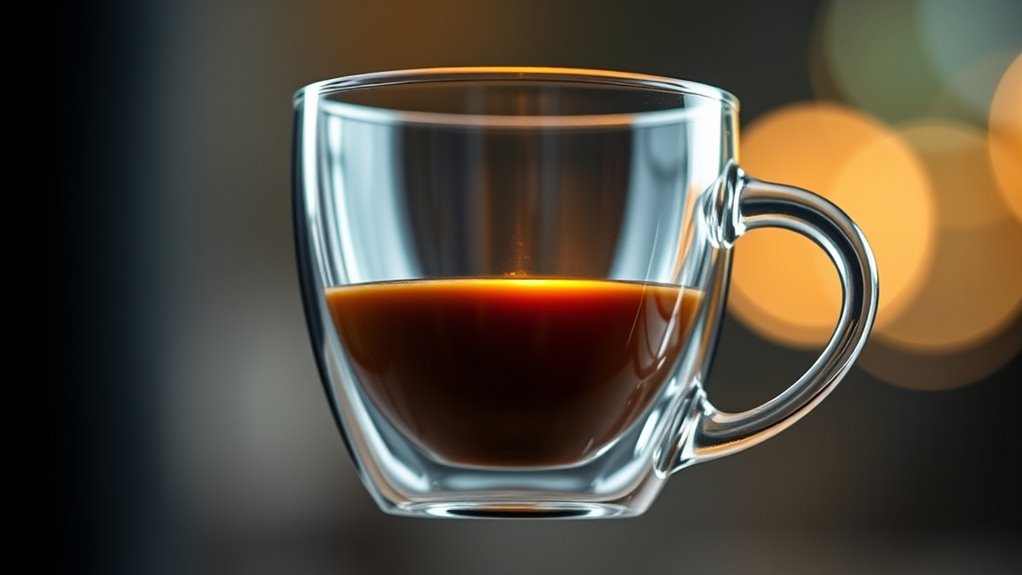
Double-walled glasses are designed with specific features that boost their insulating properties. Their double-layer construction creates a barrier that reduces heat transfer, keeping your coffee hot longer. The aesthetic appeal of these glasses isn’t just about looks; the sleek, transparent design showcases your beverage while maintaining insulation. An ergonomic design ensures you can hold the glass comfortably without feeling the heat or cold through the surface. The shape and material choices optimize heat retention without sacrificing style or usability. Additionally, the gap between the walls minimizes condensation and prevents condensation from forming on the outer surface, keeping your hands dry. These thoughtful design features combine form and function, enhancing insulation while offering an attractive, comfortable drinking experience.
Comparing Double-Walled Glasses to Other Insulated Options

While double-walled glasses are popular for their sleek design and effective insulation, they aren’t the only option available. Other insulated choices include:
- Vacuum-insulated tumblers: Known for exceptional material durability, these retain heat longer but often lack the aesthetic appeal of glass.
- Travel mugs: Made from stainless steel, they’re highly durable and practical, though they may sacrifice style for function.
- Insulated ceramic mugs: Offer a warm, cozy aesthetic appeal, but their insulation isn’t as long-lasting as double-walled glass or vacuum options.
Each option varies in material durability and aesthetic appeal, so your choice depends on whether you prioritize style, durability, or heat retention.
Practical Benefits for Coffee Lovers
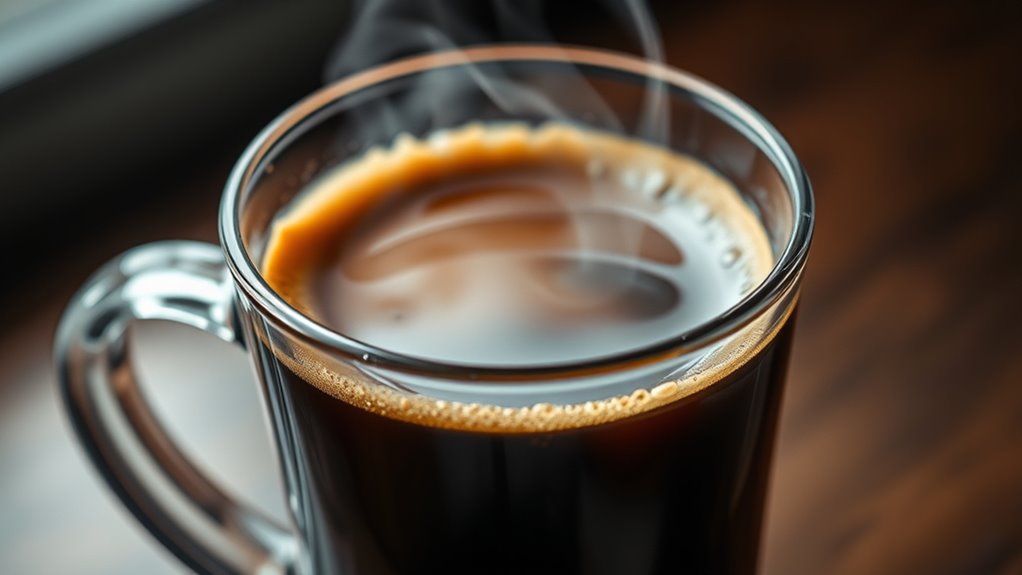
If you’re a coffee lover, double-walled glasses offer practical benefits that enhance your daily routine. They help preserve your coffee’s vibrant flavor by keeping it hot longer without overheating your hands. This means you can enjoy your brew at the perfect temperature, revealing richer, more nuanced flavors. Additionally, these glasses reduce the need for reheating, which can degrade coffee quality over time. From an environmental perspective, their durability means you’ll replace them less often, reducing waste. Plus, their insulation minimizes the use of disposable cups, lowering your overall environmental impact. Overall, double-walled glasses not only improve your coffee experience but also support more sustainable habits, making every sip more enjoyable and eco-friendly.
Future Innovations in Insulated Drinkware

Advancements in insulated drinkware are paving the way for smarter, more versatile designs that could transform your daily hydration habits. Future innovations focus on expanding color options, allowing you to personalize your cups to match your style. Manufacturers are also exploring new materials that reduce manufacturing costs, making high-quality double-walled glasses more affordable. Additionally, tech integration is on the horizon, such as smart mugs that monitor temperature or sync with your devices. These developments aim to enhance functionality without sacrificing aesthetic appeal. Picture insulated drinkware with vibrant colors, innovative features, and lower prices—making your coffee experience more enjoyable and customizable. As these innovations progress, expect your everyday drinkware to become more efficient, stylish, and tailored to your needs.
Frequently Asked Questions
How Does the Thickness of Glass Affect Its Insulating Properties?
The thickness of glass impacts its insulating properties by increasing thermal resistance, helping keep your drink hotter longer. Thicker glass has higher material density, which slows heat transfer and reduces energy loss. When you choose a thicker glass, you’re effectively creating a better barrier against external temperature changes, so your coffee stays warm. So, the more substantial the glass, the more it insulates, thanks to enhanced thermal resistance and material density.
Can Double-Walled Glasses Cause Condensation on the Outer Surface?
Did you know double-walled glasses can reduce condensation on the outer surface by up to 80%? This design helps with condensation prevention, so your hands stay dry and your table stays clean. The gap between the walls insulates the inner hot or cold drink, keeping the outer surface dry longer. So, you won’t have to worry about moisture making your hands or surfaces damp, making your drinking experience more comfortable.
Are There Health Concerns With Materials Used in Insulated Glasses?
You might wonder if materials in insulated glasses pose health safety concerns. Generally, reputable brands use safe, durable materials like borosilicate glass or high-quality plastics, ensuring long-term material durability. Always check for BPA-free labels and food-grade certifications to avoid potential health risks. By choosing well-made insulated glasses, you can confidently enjoy your hot beverages without worrying about harmful chemicals leaching or compromised safety.
How Does Ambient Temperature Influence the Insulation Performance?
Ever wondered how ambient temperature affects your insulated glass? Ambient heat transfer plays a vital role, impacting your coffee’s temperature regulation. When your surroundings are warmer, it can slow heat loss, keeping your drink hotter longer. Conversely, cooler environments accelerate heat transfer out of the glass. So, yes, ambient temperature greatly influences insulation performance, making it important to consider your environment if you want to maintain the ideal temperature for your beverage.
What Maintenance Tips Ensure Long-Term Insulation Effectiveness?
To keep your double-walled glasses insulate well, you should regularly clean them with gentle, non-abrasive materials. Avoid harsh chemicals that can damage the material, which helps maintain cleaning durability. Also, handle with care to prevent cracks or chips that reduce insulation. Proper storage extends material longevity, ensuring your glasses continue to keep your coffee hot longer. Consistent maintenance preserves insulation effectiveness and prolongs the lifespan of your glassware.
Conclusion
Now that you understand how double-walled glasses trap heat like a cozy blanket around your coffee, you can appreciate their magic. By creating a barrier against the cold, they keep your drink hotter longer and your hands cool. Think of them as the secret armor protecting your favorite brew. So, next time you savor that steaming cup, remember the science working behind the scenes to keep it perfect—your personal shield against the chill.


